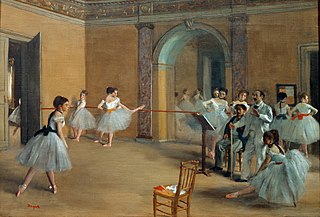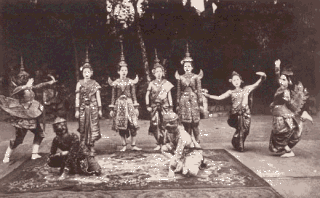
Ballet is a type of performance dance that originated during the Italian Renaissance in the fifteenth century and later developed into a concert dance form in France and Russia. It has since become a widespread and highly technical form of dance with its own vocabulary. Ballet has been influential globally and has defined the foundational techniques which are used in many other dance genres and cultures. Various schools around the world have incorporated their own cultures. As a result, ballet has evolved in distinct ways.

Music is an integral part of Mongolian culture. Among the unique contributions of Mongolia to the world's musical culture are the long songs, overtone singing and morin khuur, the horse-headed fiddle. The music of Mongolia is also rich with varieties related to the various ethnic groups of the country: Oirats, Hotogoid, Tuvans, Darhad, Buryats, Tsaatan, Dariganga, Uzemchins, Barga, Kazakhs and Khalha.
Classical may refer to:

The morin khuur, also known as the horsehead fiddle, is a traditional Mongolian bowed stringed instrument. It is one of the most important musical instruments of the Mongol people, and is considered a symbol of the nation of Mongolia. The morin khuur is one of the Masterpieces of the Oral and Intangible Heritage of Humanity identified by UNESCO.
Ballet as a music form progressed from simply a complement to dance, to a concrete compositional form that often had as much value as the dance that went along with it. The dance form, originating in France during the 17th century, began as a theatrical dance. It was not until the 19th century that ballet gained status as a "classical" form. In ballet, the terms 'classical' and 'romantic' are chronologically reversed from musical usage. Thus, the 19th century Classical period in ballet coincided with the 19th century Romantic era in music. Ballet music composers from the 17th–20th centuries, including the likes of Jean-Baptiste Lully, Pyotr Ilyich Tchaikovsky, Igor Stravinsky, and Sergei Prokofiev, were predominantly in France and Russia. Yet with the increased international notoriety seen in Tchaikovsky's and Stravinsky's lifetime, ballet music composition and ballet in general spread across the western world.

The Macedonian music refers to all forms of music associated with ethnic Macedonians. It shares similarities with the music of neighbouring Balkan countries, yet it remains overall distinctive in its rhythm and sound.

Contemporary dance is a genre of dance performance that developed during the mid-twentieth century and has since grown to become one of the dominant genres for formally trained dancers throughout the world, with particularly strong popularity in the U.S. and Europe. Although originally informed by and borrowing from classical, modern, and jazz styles, it has come to incorporate elements from many styles of dance. Due to its technical similarities, it is often perceived to be closely related to modern dance, ballet, and other classical concert dance styles.
A ballet company is a type of dance troupe which performs classical ballet, neoclassical ballet, and/or contemporary ballet in the European tradition, plus managerial and support staff. Most major ballet companies employ dancers on a year-round basis, except in the United States, where contracts for part of the year are the norm. A company generally has a home theatre where it stages the majority of its performances, but many companies also tour in their home country or internationally.

Classical ballet is any of the traditional, formal styles of ballet that exclusively employ classical ballet technique. It is known for its aesthetics and rigorous technique, its flowing, precise movements, and its ethereal qualities.

The Royal Ballet of Cambodia is a classical Khmer dance renowned for its graceful hand movements and luxurious costumes. The ballet has been closely associated with the Khmer court for over a thousand years and would traditionally accompany various royal ceremonies, including coronations, weddings, funerals, and Khmer holidays. The ballet's repertoire encompasses various ancient Khmer legends.

Contemporary ballet is a genre of dance that incorporates elements of classical ballet and modern dance. It employs classical ballet technique and in many cases classical pointe technique as well, but allows a greater range of movement of the upper body and is not constrained to the rigorously defined body lines and forms found in traditional, classical ballet. Many of its attributes come from the ideas and innovations of 20th-century modern dance, including floor work and turn-in of the legs. The style also contains many movements emphasizing the body's flexibility.
The following outline is provided as an overview of and topical guide to music:

The Mongolian State Academic Theatre of Opera and Ballet was established on 15 May 1963 as the State Musical Drama Theatre. It was split into the State Academic Theatre of Opera and Ballet and the State Academic Drama Theatre upon the resolution 132/182 of 10 May 1963 by the Council of Ministers of the People's Republic of Mongolia and the Central Committee of Mongolian People's Revolutionary Party. The State Academic Theatre of Opera and Ballet held its opening ceremony on 18 May 1963 with Tchaikovsky’s Eugene Onegin.
Prabhath Kalavidaru is a theatre group based in Bangalore, India. Started in the year 1930, this group has staged many drama performances and is famous for its ballets. One of the most popular of their ballets is Cinderella, based on the English fairy tale and since 1977, has been staged more than a thousand times by the troupe.
Noctambules is a ballet created in 1956 by Kenneth MacMillan for the Sadler's Wells Ballet. The ballet was choreographed to Humphrey Searle's Noctambules, Op. 30 written for the ballet. The set and costumes were designed by Nicholas Georgiadis. The ballet premiered on 1 March 1956 at the Royal Opera House, Covent Garden, London.

Theatre of Cambodia known as Lakhon is composed of many different genres. There are three main categories: classical, folk, and modern. Many forms of theatre in Cambodia incorporates dance movement into performances and are referred to as dance dramas.
Sembiin Gonchigsumlaa was a Mongolian composer, generally considered to have been one of the greatest contributors to modern Mongolian national music and classical music. He is credited with being the first to write Mongolian ballet music. He was also a Merited Artiste and Chairman of the Composers' Union.
Zunduin Khangal was a Mongolian classical composer of European music.
Byambasuren Sharav was a Mongolian composer and pianist.
Dagvyn Luvsansharav is a Mongolian composer. Described as having a "rich repertoire of Mongolian songs which have a special place", he is perhaps best known for his Sükhbaataryn Magtuu or his ballet Legend of the Sun. His music featured in the 1994 Mongolian film Toorog, directed by Yondonbaliin Tserendolgor. Luvsansharav became an Honoured Artist of the Republic in the early sixties.